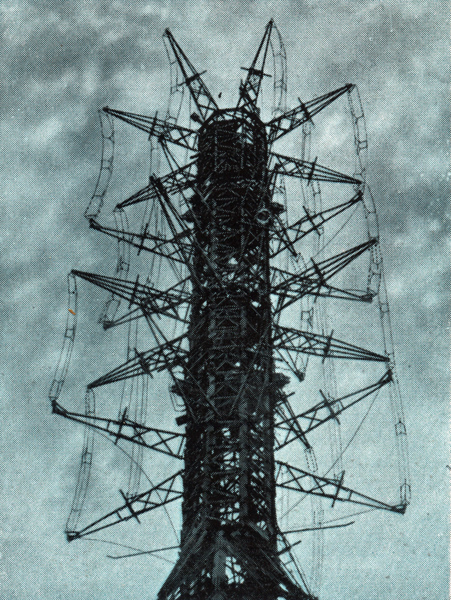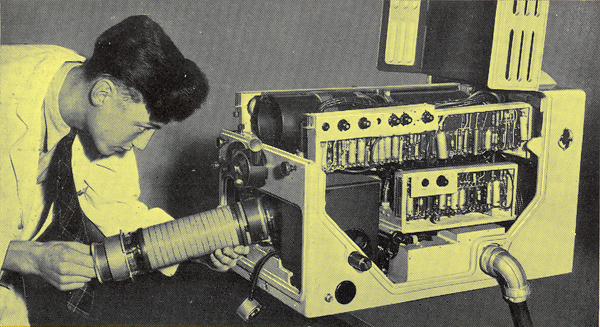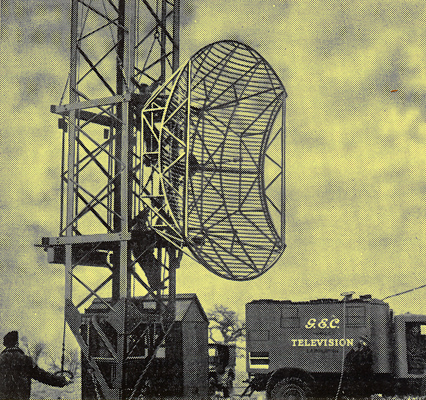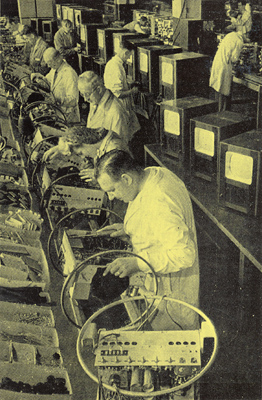|
History of the first public service

Alexandra Palace television aerials (upper, vision; lower, sound) which, at a height of nearly 200 metres above sea level, dominate North London.
All the best accounts of television begin with an early reference to the Nipkow disc, and this article is no exception. Although the present BBC television system is electronic throughout, this has not always been the case.
It was in 1929 that the original Baird system, as it was called, was introduced into the medium-wave broadcast programme for one half-hour daily. The system was a mechanical one, incorporating a Nipkow disc and providing a 30-line picture at 12= pictures per second. These programmes continued in a desultory fashion until 1935.
They had served their purpose by showing up the inherent low brightness, pronounced flicker and lack of detail inevitably associated with a conventional mechanical scanning system and the only hope of improvement appeared to lie in the adoption of some entirely new principle. Accordingly, in 1931 research was turned towards purely electronic scanning systems. On the receiving side it was decided to use the cathode-ray tube for presentation purposes, since the electron beam could be controlled entirely by voltages and currents. Up to that time, however, the cathode-ray tube had been employed solely for measurement work and considerable development was required to make it suitable for its new function and to evolve a satisfactory scanning system.
Camera Development

An interior view of the latest addition to the BBC's television equipment-the CPS Emitron camera developed by EMI Research Laboratories. The tube, which is shown with its scanning coils, is being inserted in the camera; it produces a satisfactory picture in very low lighting intensities.
For the transmitter, work was proceeding on the electron camera; or Emitron, as it was afterwards designated. This again promised, if successfully developed, to solve the problems of scanning and brightness.
The Emitron has a mosaic of thousands of combined photo electric and capacitive elements which store up the light energy constantly focused on them from the subject. A scanning electron beam discharges each in turn an directs the released energy into a suitable amplifier. The storage principle involved here is as great an advantage as the absence of moving parts. Most of this work was carried out by Electric and Musical Industries, who first of all standardized on 180 lines per picture and 25 pictures per second, but later, to improve detail and reduce flicker still further, changed to the present 405 lines, 50 frames per second interlaced.
Such a scanning system involves over 100,000 elements per picture and calls for a modulation band of at least 2MHz It had, of course, long been recognized that any high-definition system could not be accommodated within the medium-wave band and consequently a carrier frequency in the neighbourhood of 40-50MHz was chosen. Such a choice simplified the aerial system required but tended to restrict reception to little more than the horizon. The larger number of elements also involved the design of wideband video and RF amplifiers, none of which had previously been attempted. The Marconi Company collaborated in providing the RF transmitter and in consequence the system was known as the Marconi-EMI system.
Meanwhile the Baird Company had been concentrating upon mechanical systems, but some effort was devoted towards the development of the dissector camera and of cathode-ray tubes. This organization also produced an intermediate-film system of transmission. As regards standards, they favoured a 240-line picture and 25- pictures per second, calling for a modulation bandwidth of 1.5 MHz.
Another organization, which should receive at least brief mention, is the Scophony Company. It contributed a wealth of new ideas in television, mainly in connection with cylindrical lenses, high-speed scanning motors, intense light sources and the invention of the Jeffree supersonic light valve, a storage system.
Alexandra Palace
In the meantime a committee was set up by the Post Office in 1934 to examine the various systems under development and advise on the recommended procedure for inaugurating a television broadcasting service. As a result, it was decided soon afterwards that the BBC should set up a transmitting station at Alexandra Palace, some six miles north of the centre of London and standing 300 ft above sea-leve1.
In this building would be housed both the Marconi-EMI and the Baird systems for extended trials under strictly comparable conditions. Vision and sound would be radiated at 45 and 41.5 MHz respectively.
Early Transmissions
On completion the aerial system stood 600ft above sea-level, both arrays being mounted on the same mast, the sound just below the vision. The transmitters for the two systems were housed in separate rooms on the ground floor. On the first floor were the two studios, each of 70 x 30-ft floor area, with the vision control equipments located immediately adjacent. The design of these studios followed the technique favoured for film studios both as regards acoustic treatment and lighting. Ventilation, however, proved a major problem owing to the high power needed to provide an average intensity of illumination of some 150-200 ft-candles.
After a preliminary period of operation (August 26th-September 5th) during the 1936 Radiolympia exhibition when the two systems were used on alternate days, the station went into operation on November 2nd, 1936, with each system transmitting during alternate weeks. From February 1937, however, the Marconi-EMI system alone was used, its interlaced scanning with absence of flicker being considered preferable. The normal daily programme averaged about five hours total broadcasting time and included a considerable variety of subjects, such as plays of all kinds, reviews, dance bands, films, cartoons, discussions, interviews, instructional talks and demonstrations.
It must not be assumed that transmissions were confined solely to these hours or to the Alexandra Palace studios. A balanced RF cable network, installed around the centre of London, relayed to the station video signals from television cameras connected to points on the network, either directly or through short lengths of corrected telephone line. This enabled certain functions of national importance and the performances from a limited number of theatres to be televised. In addition, a mobile transmitter, consisting of three large motor vehicles, covered other events taking place within a range of 20 miles of Alexandra Palace. This transmitter operated on 64MHz with an output of 1kW peak. Finally, long camera cables permitted open-air broadcasts to be carried, out in the extensive grounds around the Palace.
The first important outside broadcast was the Coronation in 1937. Later, these broadcasts became more and more frequent with improvement in the Emitron camera and the introduction of the telephoto lens, and in 1938 and 1939 many hours were devoted to the televising of international tennis, test-match cricket and the like.
Reception

Field tests have been conducted by the GEC preparatory to choosing the sites for the four automatic radio-relay link stations which the company is erecting for the Post Office. They will link the London and, when completed, the Birmingham television stations.
Turning briefly to the reception side, it should be mentioned that, whereas the nominal zone was confined to a circle of 25 miles around Alexandra Palace, it was soon discovered that this distance could easily be exceeded and many localities further away than 70 miles were found to enjoy an adequate field strength, particularly where interference was absent. Moreover, few districts throughout the country have not received occasional transmissions during freak atmospheric conditions.
The outbreak of war in 1939 brought this service to an abrupt stop and it was not resumed again until May 1946. Since that time development work has been mainly concerned with Unsensational but steady improvement in quality of transmission and studio technique at Alexandra Palace and in developing the equipment for extending the service to other centres of population. The improvements in the working programme arise from such factors as continually increased sensitivity and freedom from background noise of the Emitron camera and new ventures in staging, continuity and mixing. A recent example of this was the greater detail and depth of focus obtained with the new CPS Emitron, particularly noticeable in the Olympic Games transmissions.
Extended Service
What lies in the future? The next step is the relay station at Sutton Coldfield, near Birmingham. Work is proceeding on the apparatus and on the relay stations which will form an RF link to feed it with programmes originating in London. An alternative link in the form of a wideband coaxial cable will also be available and will enable direct experience of both methods of relaying to be gained. The station is expected to be in operation in 12 months time and will serve not only Birmingham but a considerable part of the Midlands. It seems likely that this station will be followed by another in the Newcastle-on-Tyne area.
It is often alleged that increasing the number of lines used in scanning can effect improvements in the quality of the television system. In fact, however, in any case where the relaying of programmes over considerable distances is involved, the advantage of more lines is very questionable. From the practical point of view there is much more scope for improvement in other directions. Greater depth of focus in the transmitting cameras, to mention only one, will not only lead to a marked improvement in the picture quality but will remove one restriction upon the producer of a television programme. At the receiving end the simplification and cheapening of the apparatus are of prime importance to the popularity of television.
All these things are needed whatever the number of lines, but they are more likely to be achieved in the near future with the present system than with any greater number of lines. Because of this, the BBC has authoritatively stated that no change in the number of lines will be considered for some years. The decision is as justifiable as it is welcome. There will be plenty of time to debate the expediency of such a change when all improvements within the present system have been effected.
A word of praise is due to those who, some thirteen years ago, were responsible for the decisions around which this controversy is today centred. At that time these decisions appeared wildly optimistic: now, despite superficial arguments to the contrary, they are proved amazingly correct. It is to be hoped that those authorities who have yet to make their final decisions on this matter will be equally inspired.

Mass Production: With the number of British television licence holders increasing by some 5,000 a month receivers are now being mass produced. Moreover, with the extension of the BBC television service to the Midlands towards the end of next year and, within a short time to other thickly populated areas, there will be a continuously growing demand for receivers. This photograph was taken at the HMV factory, Hayes, Middlesex, and shows the wiring of television chassis an the final assembly of sets on parallel production lines.
|